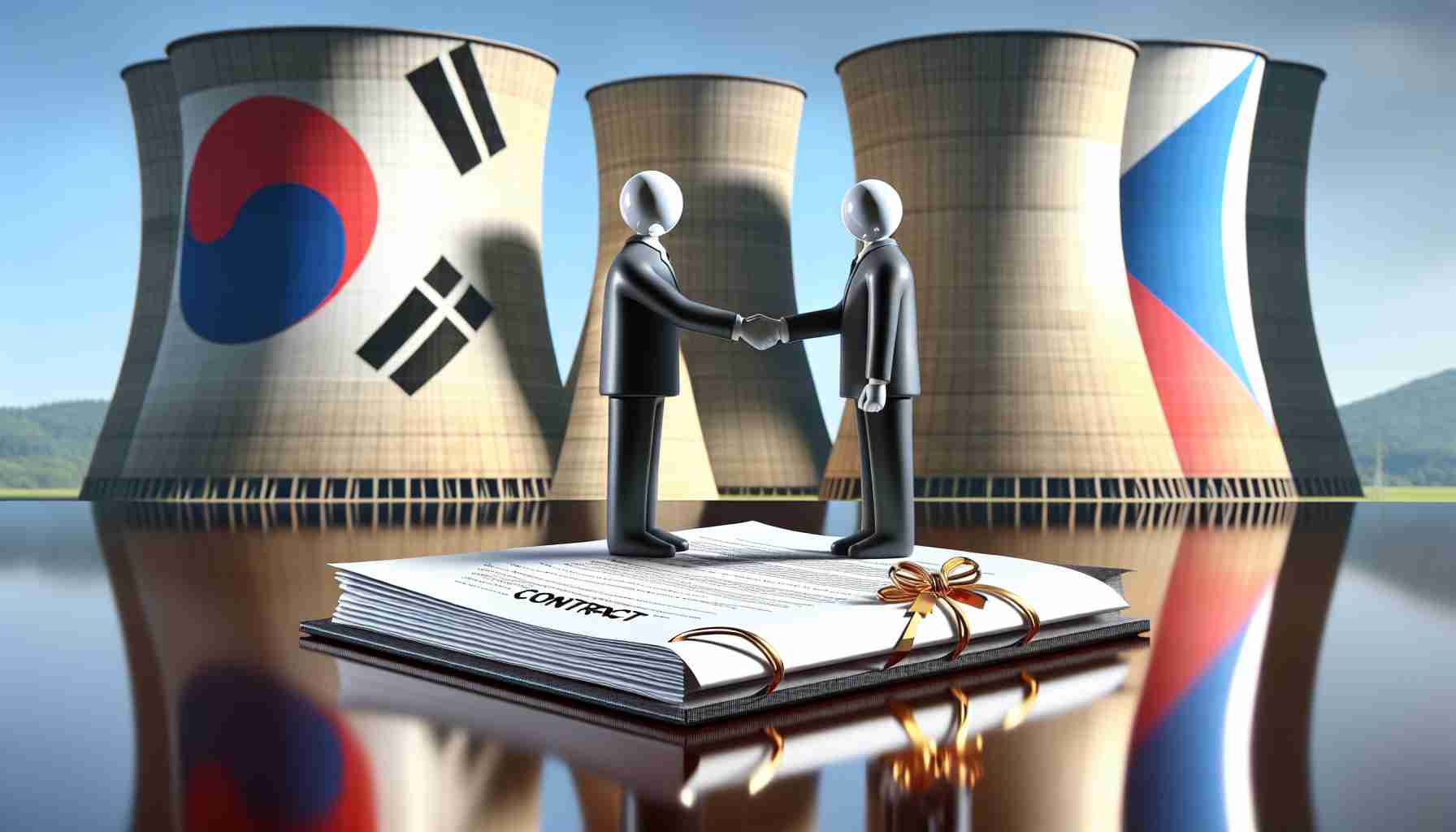A Futuristic Leap Towards Energy Innovation
In a bold stride towards a sustainable future, Duke Energy is spearheading a revolutionary transition at its Belews Creek facility in Stokes County, North Carolina. Proposing the implementation of a small modular nuclear reactor (SMR), this venture aims to decommission an outdated coal-fired plant, preparing the precinct for a new era of energy production.
What Sets SMRs Apart? Unlike their colossal predecessors, these compact reactors draw inspiration from naval nuclear technologies, heralding an era of efficiency and adaptability. This design promises not just a reduced physical footprint but also swifter deployment, positioning it as a cornerstone of modern nuclear engineering.
The Broader Impact Such an innovative shift extends beyond environmental advantages. By transitioning to nuclear energy, communities stand to benefit from skilled job creation and sustained local revenue. This change promises cleaner air and a stronger economy, potentially reshaping public views on nuclear energy.
Global Reverberations On a worldwide stage, this shift could pioneer a renewed embrace of nuclear power as a plausible alternative to fossil fuels. As nations strive to meet climate goals, technologies like SMRs offer a feasible path away from carbon dependency.
Environmental Considerations While nuclear waste management remains a widespread concern, SMR designs focus on enhancing safety and minimizing environmental footprints. As this initiative unfolds, it sets a compelling precedent for reducing emissions globally.
If approvals proceed smoothly, Duke Energy’s project could light up North Carolina by 2034, exemplifying the potential of modern nuclear solutions to transform energy landscapes for the better.
The Dawn of Small Modular Nuclear Reactors: A Game Changer for the Future
The introduction of Small Modular Reactors (SMRs) as proposed by Duke Energy at the Belews Creek facility in North Carolina represents a pivotal moment in the ongoing quest for sustainable energy solutions. By replacing an outdated coal-fired plant with cutting-edge SMR technology, this initiative addresses pressing environmental concerns while promising far-reaching implications for humanity and the global landscape.
Environmental Impact of SMRs
The transition from coal to SMRs marks a significant environmental advancement. Coal plants are notorious for their massive carbon dioxide emissions, contributing heavily to air pollution and the greenhouse effect. In contrast, nuclear reactors, including SMRs, produce minimal greenhouse gases during operation. By reducing reliance on fossil fuels, SMRs can significantly diminish carbon emissions, thereby playing a crucial role in mitigating climate change.
Furthermore, SMRs come equipped with modern technological advances that emphasize enhanced safety measures and reduced risk of environmental contamination. Their smaller size allows for better heat management and cooling processes, thereby lessening the likelihood of accidents and making them safer than traditional large-scale reactors.
Impact on Humanity and the Economy
The adoption of SMR technology has the potential to generate a wide range of benefits for communities. It promises the creation of a multitude of skilled jobs, particularly in engineering, construction, and technology sectors. This infusion of job opportunities can invigorate local economies, providing stable employment and stimulating economic growth in regions that choose to transition to nuclear technology.
Additionally, the cleaner air resulting from lower emissions translates into healthier communities with reduced medical costs associated with air pollution-related health issues. Public perception of nuclear energy, often colored by historical events, could shift positively as the community experiences the tangible benefits of cleaner, sustainable energy.
Global and Future Implications
On the global stage, the implementation of SMRs by Duke Energy could act as a catalyst, encouraging other nations to adopt similar technologies as they work toward meeting international climate goals. SMRs offer a compelling alternative to fossil fuels—an attractive proposition for countries seeking sustainable growth while reducing carbon footprints.
The appeal of SMRs extends to the future of humanity. As global populations surge and energy demands rise, sustainable and reliable energy sources like SMRs become invaluable. They offer a blueprint for integrating advanced energy technologies to alleviate the pressures of climate change. If fully embraced, SMRs could usher in an era where clean energy is not only feasible but also the norm worldwide.
By lighting up North Carolina by 2034 and setting a benchmark for modern nuclear solutions, Duke Energy’s project demonstrates the immense potential of SMRs to reshape energy landscapes, paving the way for a cleaner, sustainable, and economically vibrant future. The implications of this transition could redefine our approach to energy generation, ensuring a lasting impact on both the environment and the global community.
Revolutionary Energy Shift: How Duke Energy’s SMR Initiative Could Redefine Power
Emerging Trends and Innovations in Small Modular Reactors
Duke Energy’s ambitious proposal to integrate a small modular nuclear reactor (SMR) at its Belews Creek facility introduces a significant shift in how nuclear energy is perceived and implemented. With SMRs gaining attention as the future of nuclear technology, let’s explore the intricate aspects that set this innovation apart and how it stacks up in the global energy market.
Understanding the Unique Features of SMRs
Small modular reactors are reinventing nuclear technology with several defining features:
– Compact Design: Inspired by naval nuclear technologies, SMRs are significantly smaller than traditional reactors, which allows for easier and more flexible siting and reduced infrastructure costs.
– Enhanced Safety: Modern SMRs employ advanced safety designs that utilize passive safety systems to automatically shut down and cool without human intervention or external power sources.
– Faster Deployment: Their modularity means that they can be prefabricated and transported, leading to shortened construction times compared to large conventional reactors.
Pros and Cons of Embracing SMR Technology
Like any innovation, SMRs come with their advantages and challenges:
Pros:
– Reduced Carbon Footprint: SMRs offer a zero-emission alternative, supporting climate goals by reducing reliance on fossil fuels.
– Economic Benefits: By transitioning to SMRs, there is a potential for job creation in tech, manufacturing, and operation sectors, bolstering local economies.
– Energy Security: With decentralized power generation, SMRs can provide reliable energy and bolster energy independence.
Cons:
– Nuclear Waste Management: Handling and storage of nuclear waste continue to pose challenges, necessitating advanced management solutions.
– Public Perception: Despite improvements, the historical context of nuclear energy poses barriers to public acceptance.
Market Analysis: Demand for SMRs in a Greener Future
The global movement towards clean energy solutions positions SMRs as a key player in transitioning away from carbon-intensive energy sources. With countries aiming to meet stringent emissions targets, the market for SMRs is poised for growth. Regions with aging energy infrastructure may find SMRs particularly attractive due to their scalability and efficiency.
Security and Sustainability Aspects
SMRs incorporate state-of-the-art security measures, including robust physical protection and advanced cybersecurity protocols. From a sustainability perspective, SMRs reduce the overall fuel usage required for nuclear power and contribute less thermal pollution to nearby water bodies than large reactors.
Predicting the Future of Nuclear Energy
As Duke Energy gears up for potential operational approval by 2034, their initiative could spark a broader trend toward adopting SMRs globally. The success of such projects will likely influence public policy and regulatory environments, making SMRs a viable contender in future energy mixes.
To learn more about the innovative strategies and projects by Duke Energy in revolutionizing energy production, visit Duke Energy.
The source of the article is from the blog cheap-sound.com



